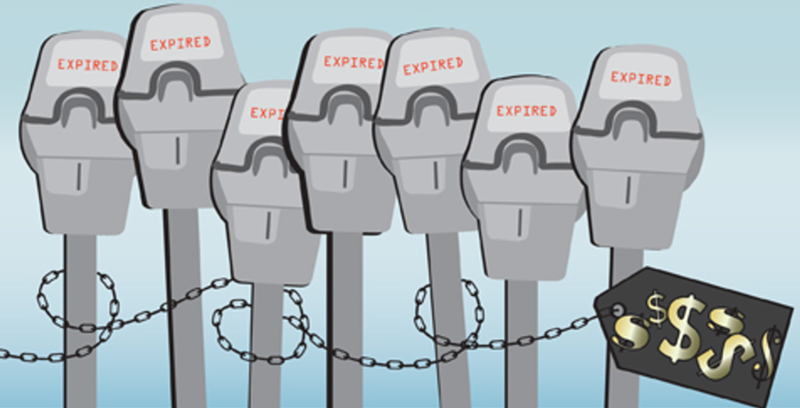Mayor John Cranley on Feb. 12 officially unveiled his plan for Cincinnati’s parking meters, lots and garages, providing the first clear option for the city’s parking system since the Greater Cincinnati Port Authority agreed to halt the previous plan.
The proposal seeks to effectively replace the previous administration’s parking privatization plan, which outsourced the city’s parking assets to the Port Authority and several private companies, and maintain local control of the city’s parking assets.
Here’s a breakdown of the plan and all its finer details.
What is Cranley’s parking plan?
It’s a plan for Cincinnati’s parking meters, lots and garages. More specifically, Cranley calls his proposal a “framework” that focuses on upgrading the city’s parking meters and keeps City Council’s control of parking rates and hours.
Cranley’s plan, based on a Feb. 7 memo from Walker Parking Consultants, achieves his goals in a few ways:
• The city would issue bonds, backed by future parking revenues, to upgrade all parking meters to accept credit card payments.
• The amount of enforcement officers under the city’s payroll would increase to 15, up from five, to provide greater coverage of the city’s parking meters. (Currently, a few areas, including major hubs like the University of Cincinnati and Over-the-Rhine, are effectively unenforced for two to five hours a day, according to Walker.)
• Neighborhood meter rates would go up by 25 cents to 75 cents an hour. Downtown rates would remain at $2 an hour.
• Sundays and holidays remain free.
Cranley says the underlying idea is to maintain a few key principles, particularly local control over rates and hours. He cautions Walker’s proposal, including expanded enforcement hours, could change with public input and as City Council puts together the final plan.
Does the plan let people use smartphones to pay for parking meters?
No. Cranley says the upgraded meters will support the technology, but it will be up to council to decide whether it’s enabled in the future.
Smartphone capability is a double-edged sword: It introduces its own set of costs, including shorter battery life for meters. It also allows customers to avoid under- and overpaying at parking meters, which decreases citation and meter revenues. But smartphone access also increases ease of use, which could lead to higher revenues by making it easier to pay.
The parking privatization plan promised to provide smartphone access at all parking meters. The previous administration and Port Authority championed the feature as key to increasing convenience and revenue.
OK, that explains the parking meters. What about the parking garages?
Cranley’s plan makes two changes to garages:
• The Port Authority would take over Fountain Square South Garage. The Port would be required to cover expenses for the garage, but any net revenue could be used on projects within the city.
• The city would issue bonds, backed by future parking revenues, to build a garage at 7th and Broadway streets.
Otherwise, things remain the same as today.
In other words, the city would be on the hook for parking garage repairs and upgrades, which Walker estimates would cost roughly $8 million in capital expenses over the next five years.
But the city would also continue directly receiving around $2 million per year in net revenue from parking garages, according to Walker.
Still, the city isn’t allowed under state law to use the revenue from parking garages for anything outside the parking system.
The parking privatization plan tried to do away with the restriction by putting the Port Authority in charge of garages. State law allows agencies like the Port to tap into garage revenues for other uses, such as development projects.
But without the previous administration’s plan, Cranley claims the Port Authority declined to take over more facilities beyond Fountain Square South Garage. Given the rejection, Cranley says it’s up to council to figure out another way to leverage garage revenues beyond putting them back in the parking system.
What does Cranley’s plan do about the thousands of parking tickets already owed to the city?
Nothing. By Cranley’s own admission, the city needs to do a better job collecting what it’s owed. But he says that’s something City Council will have to deal with in the future.
So why did Cranley oppose the parking privatization plan?
Cranley vehemently opposed giving up local control of the city’s parking assets. He warned that outsourcing meters to the Port Authority and private companies would create a for-profit incentive to ratchet up parking rates and enforcement.
The previous administration disputed Cranley’s warnings. They pointed out an advisory board, chaired by four Port Authority appointees and one city appointee, would need to unanimously agree on rate and hour changes, and the changes could be vetoed by the city manager.
Without any changes from the advisory board, the 30-year privatization plan hiked downtown parking meter rates by 25 cents every three years and neighborhood rates by 25 cents every six years. The plan also expanded enforcement hours to 8 a.m.-9 p.m. in Over-the-Rhine and parts of downtown.
Still, City Council would lose its control of rates and hours under the privatization plan. Cranley and other opponents argued the outsourcing scheme could insulate the parking system from public — and voter — input.
Cranley also opposed the privatization plan’s financial arrangement.
Under the old deal, the city would receive a lump sum of $85 million and annual installments of $3 million, as long as required expenses, such as costly garage upgrades or repairs, were met.
In comparison, the city currently gets roughly $3 million in net revenue from parking meters and another $2 million in net revenue from parking garages. (As noted earlier, the parking garage revenue can only be used for parking expenses.)
Cranley characterizes the lump sum as “borrowing from the future” because it uses upfront money that could instead be taken in by the city as annual revenue.
Related: Compare Cranley’s plan with the parking privatization plan.
Why does Cranley think his proposal is necessary?
It solidifies the death of the parking privatization plan. That’s important to begin the process of legally dismantling the previous plan.
The plan also increases net parking meter revenues from roughly $3 million to $6 million in the next budget year and more than $7 million per year within five years, according to Walker’s original estimates. (The estimates are likely too high because they assumed evening hours would expand around the University of Cincinnati, Short Vine in Corryville, Over-the-Rhine and downtown. But Cranley shelved the expansion of hours, with no estimates for how the changes will affect revenues.)
Since parking meter revenue, unlike garage revenue, can be used for non-parking expenses, the extra revenue could help plug the $20 million gap in the $370 million operating budget.
Why do some people oppose Cranley’s plan?
Some people supported the parking privatization plan. They saw the lump sum as a great opportunity to invest in development projects around the city. Without the lump sum, critics claim Cranley’s plan accepts all the pain of the previous plan — increased enforcement, rates and hours — for very little gain, even though the city would get more annual revenue and upgraded parking meters and garages.
Politics are also involved. After the contentious streetcar debate, there’s not much Cranley can do without some critics speaking out.
When will Cranley’s plan go into effect?
City Council first has to approve Cranley’s plan for it to become law. Council will likely take up and debate the plan at the Neighborhood Committee on Feb. 24 and set a more concrete timeline after that.
This blog post will be regularly updated as more information becomes available. Latest update: Feb. 19.






